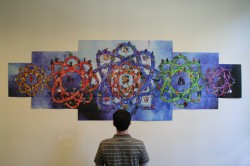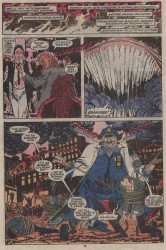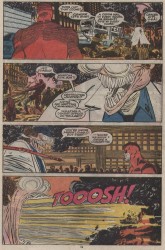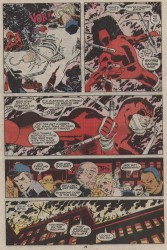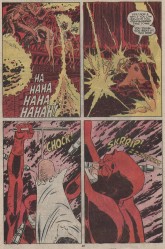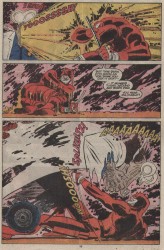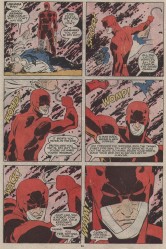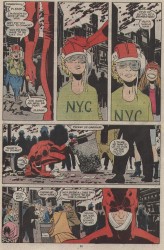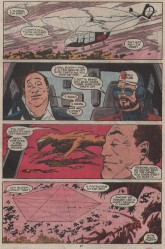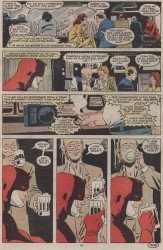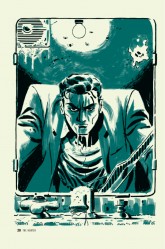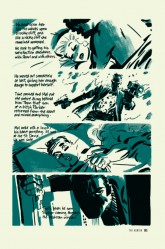Yotsuba&! 6 is very, very funny. Easily the best book in the series thus far, if only due to the way the stories end up snowballing into a larger tale. Yotsuba’s trek to Fuuka’s school did an amazing job of capturing just how awesome real life is, which is something Yotsuba&! already does very well.
You already know how much I like Yotsuba&! Rather than doing a recap and review of volume 6, I want to discuss something that makes me love it a little less.
My problem is with the translation. It’s not to my liking, to be honest, and pales in comparison to the ADV Translation. It’s not that it’s bad, exactly, but it is a little too faithful to the source material.
Part of the beauty of Yotsuba&! is that the source material is very, very strong. The relatively few cultural jokes have easy analogues, as in Miura visits the Ayase household dressed as a cardboard robot. In the ADV translation, she says that her name is Cardbo. That’s pretty easy, right? Cardbo->Cardbord->Cardboard robot. It makes sense.
In the Yen Press translation, Miura calls herself Danbo, a reference to the Japanese word for cardboard. And, okay, that’s cool, but it isn’t a joke, exactly. It’s a reference with a footnote. It’s like when someone tells you a joke, and you don’t laugh because you don’t get it, and then they explain why it was funny. The problem is that after all of that… it still isn’t funny. You get it, but you don’t laugh.
Similar to the Danbo translation is the use of honorifics– chan, san, and so on. While an integral part of Japanese, they don’t really have any place in English. It’s another joke that doesn’t work. There are ways around it, of course– Fuuka-neesan can just be “big sis,” for example. Oftentimes, however, nothing is truly lost by leaving them out. An adult referring to Yotsuba in Japan may say “Yotsuba-chan,” while an American would say “Yotsuba.” Both are equally valid and both read the same. The chan is just a clue for us to go “Oh! She’s talking to a child!”
The sound effects are also left untranslated, for the same reason that I assume the honorifics were left in. Untranslated isn’t exactly right, though. There are little notes next to the first iteration of each sound effect in a group that explains what the sound is. Otherwise, the sfx are untouched.
It’s a little lame and distracting, if I’m being perfectly honest. It’s another case of being too faithful. I’ve been reading manga for a long time. I know that “doki doki” is the sound of a heartbeat, “ora ora ora!” is what people say when they’re punching someone over and over, and that chicks go “piyo piyo!”
The thing is, that sort of thing doesn’t really translate. It tends to just look silly, and yep, in Yotsuba&!’s new translation, it looks silly. When the Japanese sound effects are left in the text, the book ends up looking more like a fan translation rather than a professional work.
Fans are notable for being extremely reluctant to be anything but absolutely faithful to the source material in an attempt to be truly authentic. This often leads to awkward, or nonsensical translations. Yotsuba&! being strong enough to shine through an awkward translation doesn’t make the translation any less awkward. The honorifics don’t add anything to the book, beyond it seeming more “Japanese.” It’s like the book has been translated, but not localized.
Part of the draw of Yotsuba is how it’s fairly minimalist, to borrow an idea from Jeff Lester. His specific example was toward the end of Yotsuba & Delivering, when Koiwai bonks Yotsuba on the head for bicycling so far away from home. It’s a completely white panel with Koiwai, his fist bonking Yotsuba on her gigantic head, the sound effect in kana, the romanization of the sound effect (“go”), and “bonk” in parentheses.
In the original Japanese, it’s a very simple and to the point panel. However, in Yen Press’s translation, it’s got the romanization and the actual translation on top of the kana, which just clutters things up. It takes away from the minimalist style of the panel. The problem is that editing out the kana and simply inserting a “bonk” sound effect in an appropriate style would’ve been much more straightforward and, well, funny. The panel has two bits: Koiwai bonking Yotsuba and the “bonk” sound. Instead, it has the bonking action, a symbol that’s essentially meaningless to me, the translation of that symbol, and then the actual sound effect. It’s too much. It weakens the joke by layering on too much information.
My favorite translation, bar none, is the Geneon Lupin the Third dub. It took an old series that would not have benefitted very much from a direct translation (judging by the original Monkey Punch manga I used to own), looked at the characters and their personalities, and crafted new lines and jokes based on that. The characters never felt out of character or inappropriate, and the jokes were actually funny, rather than just being references to Japanese pop culture. This is an extreme example, of course, but it shows how this kind of thing can work.
It’s similar to how ADV approached their Yotsuba&! translation. Certain things won’t translate seamlessly, but rather than compromise a very funny book by making it less funny, they bent the rules a little and kept the book’s spirit, if not its letter.
I totally understand why Yen Press’s translation is the way it is. JuYoun Lee, Senior Editor at Yen Press, gave an illuminating interview with Deb Aoki over the translation. I don’t agree with the way they chose to go, but it makes sense from a certain angle. It’s more accurate and exact, but I don’t think that that is a universally good thing. It leads to too many jokes ending up explained, rather than allowed to breathe, distracting gremlins ending up on the page, and having to qualify my love for the series when recommending it to people.
At one point during Yotsuba&! 6, Koiwai says, “I love the way she reacts to stuff like this.” That sums up the entire series. It’s got a strong dose of humor, wonder, and love. The source material is some of the best out. Yotsuba&! is a very, very good series, but certain aspects of the translation are disappointing. That isn’t a dealbreaker, but I wish it were a little better. It deserves it.



